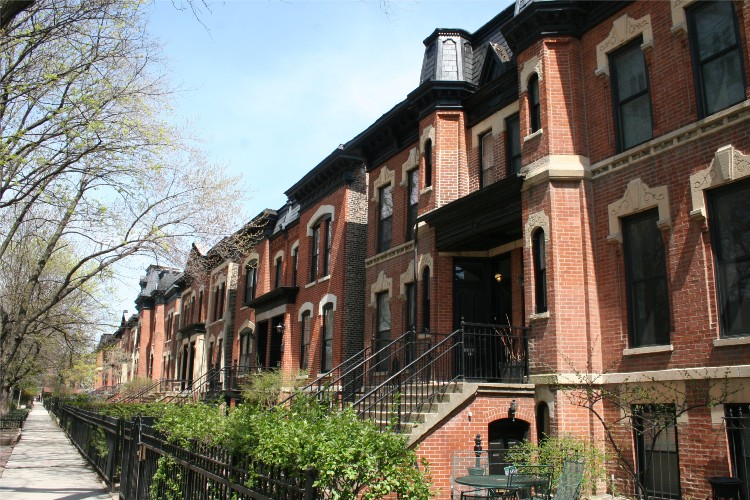By Anne Shilinglaw, Class of 2015

Wandering around the Historic Sheffield district provides a wonderful refresher course in Chicago history as well as a compendium of architectural features. Very much an early post-Fire neighborhood, many of the homes were built in the 1880s and ‘90s, either in brick or stone, per building code mandates. Indeed, it’s the materials and ornamentation, featuring exemplary artisanship, that attract my eye, especially since much of the area is devoted to historic preservation.
Some of the structures were built as private residences for those on the “social register”, while others, including three landmarked rowhouse districts from the 1870s and ‘80s, were designed for blue collar workers or for seminarians attending the McCormick Theological Seminary.
One such district, the Bissell Street Rowhouses, is a storehouse of historical and architectural anecdotes. Taking up both sides of the 2100 block between Dickens and Webster are 20 buildings containing an original total of 120 units, designed by architect Iver Zarbell and completed in 1883. Rowhouses made economic sense as the developer could save on land, materials, and construction costs. At Zarbell’s insistence, the rowhouses did not have a homogenous look. Instead, differing roof lines predominate on the 3, 6, or 9-flat structures, featuring simplified Queen Anne styling, while others are Italianate, and still others are Second Empire, with Mansard roofs.

Now, onto the historical: during the 1889 expansion of the elevated tracks in the neighborhood, several of the rowhouse buildings interfered with the designated construction path. Employing eminent domain, the city removed 15 feet from the back of several units, specifically the kitchen, bedrooms and back yards. While exploring the area, walk west on Dickens to the EL tracks and notice the different colorations on the brick backs of the buildings!
Another fun bit history: courtesy of the 2007 Commission on Chicago Landmarks designation report, we know the professions of the original tenants in 1883 — Chicago Board of Trade clerks, traveling salesmen, a milliner, members of the Chicago police force, saloon keepers, a music teacher, and street car conductors.
So, in the coming months, when the outdoors is a healthy and safe place to be, don your coat and hat and get some fresh air. Explore a neighborhood, and importantly, look up! When I take off my docent hat and wander around Sheffield, I put together a “wish list” of architectural elements and ornamentations I want to feature in my dream house when I win the lottery. I note the varying roof lines, window shapes, and placements. Do I want balconies or a large veranda, perhaps a mixture of façade materials, maybe go bold with a turret? Some Eastlake spindles or filigree? A Romanesque arched entry would be quite the statement, but then so too would be some façade one-of-a kind decorative elements created by talented brick artisans or stone masons. And my overall architectural style: Empire, Italianate, Queen Anne, Moorish, Romanesque? The possibilities are endless, and so much fun to consider!


WONDERFUL piece! Thanks for the exquisite peek and the encouragement to get out and enjoy our City!
I look forward to exploring this group of townhouses. Thanks for writing this!